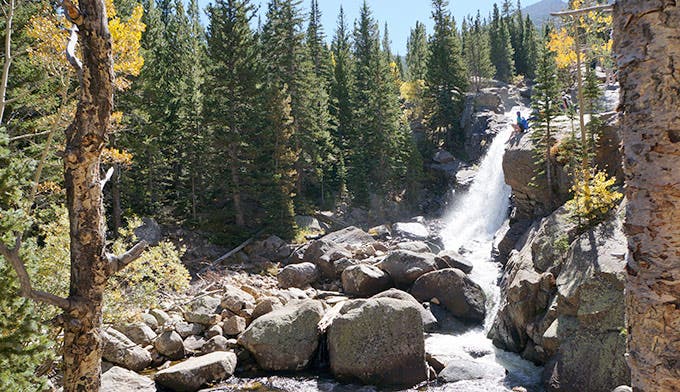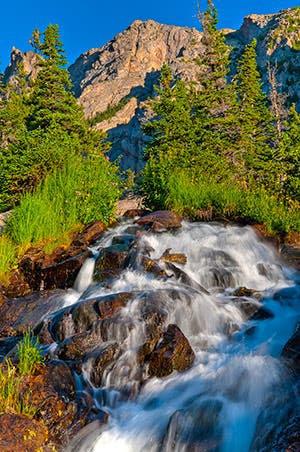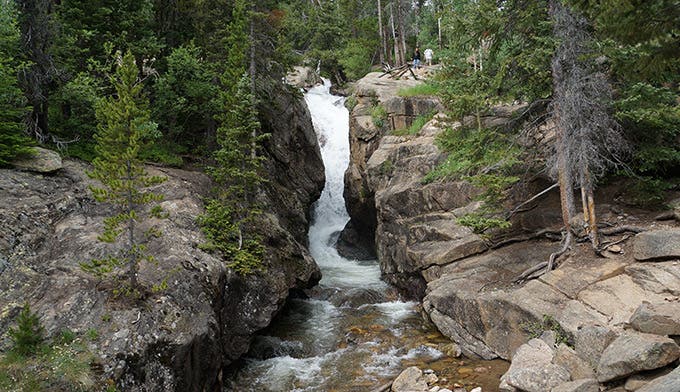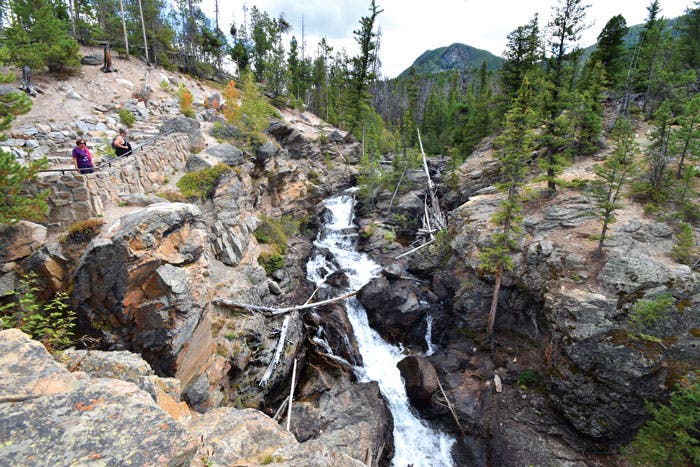14 Favorite Waterfalls in Rocky Mountain National Park

Horseshoe Falls in Rocky Mountain National Park. (Photo: Depositphotos)
Rocky Mountain National Park’s impressive backcountry is renowned for rugged alpine terrain formed by heavy glacier activity thousands of years ago. Deep cirques, long valleys and talus peaks are typical examples, but waterfalls, usually the byproduct of glacier episodes, can be found as well.
All but one of Rocky Mountain Park’s waterfalls require at least a short hike. Some falls even take days and off-trail hiking to access. The lack of quick roadway access means even though approximately 4 million people visit the park each year, it’s entirely possible to enjoy a waterfall by yourself.
A majority of the park’s waterfalls can be found east of the Continental Divide in two heavily concentrated areas: Wild Basin and Glacier Gorge. Fern Lake Trailhead is also a key place to access several waterfalls, but typically is packed with visitors because of its close proximity to Moraine Park and Moraine Park Campground.
Waterfalls On the East Side
Glacier Gorge Trailhead
The path starting at the Glacier Gorge Trailhead has ideal spots to catch impressive falls without having to go too far. To miss the crowds head there in early morning or late evening since peak rush hours are typically in the afternoon.
Alberta Falls is the first major fall on this trail at just 0.8 miles from the trailhead. It leaps 25 feet, crashing into boulders below. During autumn, glowing aspens line the trail and creek creating a golden canopy.

Past Alberta Falls, about a half-mile further up the trail, you’ll reach Mills Junction. To continue on towards Mills Lake and Black Lake, hikers should turn left at this junction. At 2.4 miles hikers will cross over Glacier Creek. Just past the footbridge you can follow the creek off-trail for about 60 feet to see Glacier Falls, a 30-foot waterfall viewed from its base. Continue up the trail past Mills Lake. Near the end of the Black Lake Trail, you will come to a meadow at the base of Ribbon Falls. The last bit of the hike to the lake takes you beside the falls to the top.

Wild Basin Trailhead
Start your hike at the Wild Basin Trailhead accessible from the Wild Basin Entrance in the southeastern corner of Rocky Mountain National Park. This entrance is located near the small communities of Meeker Park and Allenspark.
As you hike, Copeland Falls comes up quickly, but is really just a short leap. During high water this fall can be considered more of a cascade. After passing Calypso Cascades, a long violent cascade pouring down several small steps, the trail reaches Ouzel Falls, one of the most popular and beautiful falls inside the park. More than 40 feet high, Ouzel Falls has several viewing areas, including our favorite along a short social trail on the left side of the falls. Further up several more waterfalls can be accessed including: Trio Falls, Thunder Falls and Lyric Falls.

Old Fall River Road
Chasm Falls is the only waterfall visible by car east of the continental Divide. It can be found along Old Fall River Road.
The fall leaps 30 feet and during peak flow is incredibly loud. To see the falls, park in the marked lot and walk a few hundred yards down stone steps to the viewing area.

Waterfall Hikes on the West Side
If visiting the park’s western slope several waterfalls are accessible, but unlike the eastern slope they may require a longer hike in.
Tonahutu/North Inlet Trail
One of the most popular trailheads is the Tonahutu/North Inlet Trailhead. From here Cascade Falls, War Dance Falls, and North Inlet Falls can be accessed. We strongly recommend visiting this section during early summer when the snow is melting and the creeks will be at peak flow.

East Inlet Trail
Another good option is to head 0.3 miles up the East Inlet Trail to Adams Falls. The fall slides off a 15-foot ledge into a calm pool below. Using a slow shutter you can get incredible photos as this is a popular photography destination because of the area’s lush vegetation and unique rock formations.
Complete List of Named Waterfalls
Want to complete your waterfall list? Here are all 31 named waterfalls in Rocky Mountain National Park.
Adams Falls
Alberta Falls
Bridal Veil Falls
Calypso Cascades
Cascade Falls
Chaos Canyon Cascades
Chasm Falls
Columbine Falls
Copeland Falls
East Inlet Falls
Fan Falls
Fern Falls
Glacier Falls
Grace Falls
Granite Falls
Horseshoe Falls
Lost Falls
Lyric Falls
Marguerite Falls
McGregor Falls
Mertensia Falls
North Inlet Falls
Ouzel Falls
Ribbon Falls
Thousand Falls
Thunder Falls
Timberline Falls
Trio Falls
War Dance Falls
West Creek Falls
Windy Gulch Cascades
Source: www.joeandfrede.com/colorado/RMNP_named_falls.htm

Need a map? Download an official Rocky Mountain National Park map for basic road and attraction locations. Want a detailed topographical map of trails in the park? Buy the National Geographic Trails Illustrated Map for Rocky Mountain National Park at REI.com. The map includes trails, trailheads, points of interest, campgrounds, lakes and much more printed on waterproof, tear-resistant material.